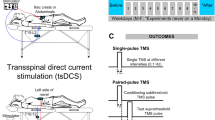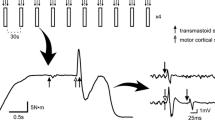Abstract
Spinal DC stimulation (tsDCS) shows promise as a technique for the facilitation of functional recovery of motor function following central nervous system (CNS) lesion. However, the network mechanisms that are responsible for the effects of tsDCS are still uncertain. Here, in a series of experiments, we tested the hypothesis that tsDCS increases the excitability of the long-latency stretch reflex, leading to increased excitability of corticospinal neurons in the primary motor cortex. Experiments were performed in 33 adult human subjects (mean age 28 ± 7 years/14 females). Subjects were seated in a reclining armchair with the right leg attached to a footplate, which could be quickly plantarflexed (100 deg/s; 6 deg amplitude) to induce stretch reflexes in the tibialis anterior (TA) muscle at short (45 ms) and longer latencies (90–95 ms). This setup also enabled measuring motor evoked potentials (MEPs) and cervicomedullary evoked potentials (cMEPs) from TA evoked by transcranial magnetic stimulation (TMS) and electrical stimulation at the cervical junction, respectively. Cathodal tsDCS at 2.5 and 4 mA was found to increase the long-latency reflex without any significant effect on the short-latency reflex. Furthermore, TA MEPs, but not cMEPs, were increased following tsDCS. We conclude that cathodal tsDCS over lumbar segments may facilitate proprioceptive transcortical reflexes in the TA muscle, and we suggest that the most likely explanation of this facilitation is an effect on ascending fibers in the dorsal columns.




Similar content being viewed by others
Data availability
The datasets generated during the current study are available from the corresponding author on reasonable request.
References
Aguilar J, Pulecchi F, Dilena R et al (2011) Spinal direct current stimulation modulates the activity of gracile nucleus and primary somatosensory cortex in anaesthetized rats. J Physiol 589:4981–4996. https://doi.org/10.1113/jphysiol.2011.214189
Albuquerque PL, Mendonça T, Campêlo M et al (2018) Does trans-spinal direct current stimulation modulate the Hoffmann reflexes of healthy individuals? A systematic review and meta-analysisc. Spinal Cord 56:1022–1031. https://doi.org/10.1038/s41393-018-0149-0
Antal A, Alekseichuk I, Bikson M et al (2017) Low intensity transcranial electric stimulation: safety, ethical, legal regulatory and application guidelines. Clin Neurophysiol off J Int Fed Clin Neurophysiol 128:1774–1809. https://doi.org/10.1016/j.clinph.2017.06.001
Awosika OO, Sandrini M, Volochayev R et al (2019) Transcutaneous spinal direct current stimulation improves locomotor learning in healthy humans. Brain Stimulat 12:628–634. https://doi.org/10.1016/j.brs.2019.01.017
Bączyk M, Jankowska E (2018) Long-term effects of direct current are reproduced by intermittent depolarization of myelinated nerve fibers. J Neurophysiol 120:1173–1185. https://doi.org/10.1152/jn.00236.2018
Berry HR, Tate RJ, Conway BA (2017) Transcutaneous spinal direct current stimulation induces lasting fatigue resistance and enhances explosive vertical jump performance. PLoS ONE 12:e0173846. https://doi.org/10.1371/journal.pone.0173846
Bocci T, Vannini B, Torzini A et al (2014) Cathodal transcutaneous spinal direct current stimulation (tsDCS) improves motor unit recruitment in healthy subjects. Neurosci Lett 578:75–79. https://doi.org/10.1016/j.neulet.2014.06.037
Bocci T, Barloscio D, Vergari M et al (2015a) Spinal direct current stimulation modulates short intracortical inhibition. Neuromodulation J Int Neuromodulation Soc 18:686–693. https://doi.org/10.1111/ner.12298
Bocci T, Caleo M, Vannini B et al (2015b) An unexpected target of spinal direct current stimulation: interhemispheric connectivity in humans. J Neurosci Methods 254:18–26. https://doi.org/10.1016/j.jneumeth.2015.07.012
Bocci T, Marceglia S, Vergari M et al (2015c) Transcutaneous spinal direct current stimulation modulates human corticospinal system excitability. J Neurophysiol 114:440–446. https://doi.org/10.1152/jn.00490.2014
Christensen LO, Petersen N, Andersen JB et al (2000) Evidence for transcortical reflex pathways in the lower limb of man. Prog Neurobiol 62:251–272. https://doi.org/10.1016/s0301-0082(00)00007-1
Cogiamanian F, Vergari M, Pulecchi F et al (2008) Effect of spinal transcutaneous direct current stimulation on somatosensory evoked potentials in humans. Clin Neurophysiol off J Int Fed Clin Neurophysiol 119:2636–2640. https://doi.org/10.1016/j.clinph.2008.07.249
Cogiamanian F, Vergari M, Schiaffi E et al (2011) Transcutaneous spinal cord direct current stimulation inhibits the lower limb nociceptive flexion reflex in human beings. Pain 152:370–375. https://doi.org/10.1016/j.pain.2010.10.041
Danner SM, Hofstoetter US, Ladenbauer J et al (2011) Can the human lumbar posterior columns be stimulated by transcutaneous spinal cord stimulation? A modeling study. Artif Organs 35:257–262. https://doi.org/10.1111/j.1525-1594.2011.01213.x
Dongés SC, Bai S, Taylor JL (2017a) Concurrent electrical cervicomedullary stimulation and cervical transcutaneous spinal direct current stimulation result in a stimulus interaction. Exp Physiol 102:1309–1320. https://doi.org/10.1113/EP086360
Dongés SC, D’Amico JM, Butler JE, Taylor JL (2017b) The effects of cervical transcutaneous spinal direct current stimulation on motor pathways supplying the upper limb in humans. PLoS ONE 12:e0172333. https://doi.org/10.1371/journal.pone.0172333
Eccles JC, Kostyuk PG, Schmidt RF (1962) The effect of electric polarization of the spinal cord on central afferent fibres and on their excitatory synaptic action. J Physiol 162:138–150. https://doi.org/10.1113/jphysiol.1962.sp006920
Fernandes SR, Salvador R, de Carvalho M, Miranda PC (2021) Modelling studies of non-invasive electric and magnetic stimulation of the spinal cord. In: Makarov SN, Noetscher GM, Nummenmaa A (eds) Brain and human body modeling 2020. Springer International Publishing, Cham, pp 139–165
Frisk RF, Jensen P, Kirk H et al (2017) Contribution of sensory feedback to plantar flexor muscle activation during push-off in adults with cerebral palsy. J Neurophysiol 118:3165–3174. https://doi.org/10.1152/jn.00508.2017
Grey MJ, Ladouceur M, Andersen JB et al (2001) Group II muscle afferents probably contribute to the medium latency soleus stretch reflex during walking in humans. J Physiol 534:925–933. https://doi.org/10.1111/j.1469-7793.2001.00925.x
Hofstoetter US, Freundl B, Binder H, Minassian K (2018) Common neural structures activated by epidural and transcutaneous lumbar spinal cord stimulation: elicitation of posterior root-muscle reflexes. PLoS ONE 13:e0192013. https://doi.org/10.1371/journal.pone.0192013
Jankowska E (2017) Spinal control of motor outputs by intrinsic and externally induced electric field potentials. J Neurophysiol 118:1221–1234. https://doi.org/10.1152/jn.00169.2017
Jankowska E, Kaczmarek D, Bolzoni F, Hammar I (2017) Long-lasting increase in axonal excitability after epidurally applied DC. J Neurophysiol 118:1210–1220. https://doi.org/10.1152/jn.00148.2017
Kiehn O (2006) Locomotor circuits in the mammalian spinal cord. Annu Rev Neurosci 29:279–306. https://doi.org/10.1146/annurev.neuro.29.051605.112910
Knikou M, Dixon L, Santora D, Ibrahim MM (2015) Transspinal constant-current long-lasting stimulation: a new method to induce cortical and corticospinal plasticity. J Neurophysiol 114:1486–1499. https://doi.org/10.1152/jn.00449.2015
Kuck A, Stegeman DF, van Asseldonk EHF (2017) Modeling trans-spinal direct current stimulation for the modulation of the lumbar spinal motor pathways. J Neural Eng 14:056014. https://doi.org/10.1088/1741-2552/aa7960
Ladenbauer J, Minassian K, Hofstoetter US et al (2010) Stimulation of the human lumbar spinal cord with implanted and surface electrodes: a computer simulation study. IEEE Trans Neural Syst Rehabil Eng Publ IEEE Eng Med Biol Soc 18:637–645. https://doi.org/10.1109/TNSRE.2010.2054112
Lefaucheur J-P, Antal A, Ayache SS et al (2017) Evidence-based guidelines on the therapeutic use of transcranial direct current stimulation (tDCS). Clin Neurophysiol off J Int Fed Clin Neurophysiol 128:56–92. https://doi.org/10.1016/j.clinph.2016.10.087
Liebetanz D, Koch R, Mayenfels S et al (2009) Safety limits of cathodal transcranial direct current stimulation in rats. Clin Neurophysiol off J Int Fed Clin Neurophysiol 120:1161–1167. https://doi.org/10.1016/j.clinph.2009.01.022
Marsden CD, Merton PA, Morton HB et al (1981) Reliability and efficacy of the long-latency stretch reflex in the human thumb. J Physiol 316:47–60. https://doi.org/10.1113/jphysiol.1981.sp013771
Murray LM, Tahayori B, Knikou M (2018) Transspinal direct current stimulation produces persistent plasticity in human motor pathways. Sci Rep 8:717. https://doi.org/10.1038/s41598-017-18872-z
Nielsen JB (2016) Human spinal motor control. Annu Rev Neurosci 39:81–101. https://doi.org/10.1146/annurev-neuro-070815-013913
Nielsen J, Petersen N (1995) Changes in the effect of magnetic brain stimulation accompanying voluntary dynamic contraction in man. J Physiol 484(Pt 3):777–789. https://doi.org/10.1113/jphysiol.1995.sp020703
Nielsen J, Petersen N, Deuschl G, Ballegaard M (1993) Task-related changes in the effect of magnetic brain stimulation on spinal neurones in man. J Physiol 471:223–243. https://doi.org/10.1113/jphysiol.1993.sp019899
Nielsen JB, Christensen MS, Farmer SF, Lorentzen J (2020) Spastic movement disorder: should we forget hyperexcitable stretch reflexes and start talking about inappropriate prediction of sensory consequences of movement? Exp Brain Res 238:1627–1636. https://doi.org/10.1007/s00221-020-05792-0
Nitsche MA, Paulus W (2000) Excitability changes induced in the human motor cortex by weak transcranial direct current stimulation. J Physiol 527(Pt 3):633–639. https://doi.org/10.1111/j.1469-7793.2000.t01-1-00633.x
Nitsche MA, Cohen LG, Wassermann EM et al (2008) Transcranial direct current stimulation: state of the art 2008. Brain Stimulat 1:206–223. https://doi.org/10.1016/j.brs.2008.06.004
Petersen N, Christensen LO, Morita H et al (1998) Evidence that a transcortical pathway contributes to stretch reflexes in the tibialis anterior muscle in man. J Physiol 512(Pt 1):267–276. https://doi.org/10.1111/j.1469-7793.1998.267bf.x
Petersen NT, Pyndt HS, Nielsen JB (2003) Investigating human motor control by transcranial magnetic stimulation. Exp Brain Res 152:1–16. https://doi.org/10.1007/s00221-003-1537-y
R Core Team (2018) R: a language and environment for statistical computing, 2018
Roy RR, Harkema SJ, Edgerton VR (2012) Basic concepts of activity-based interventions for improved recovery of motor function after spinal cord injury. Arch Phys Med Rehabil 93:1487–1497. https://doi.org/10.1016/j.apmr.2012.04.034
Schweizer L, Meyer-Frießem CH, Zahn PK et al (2017) Transcutaneous spinal direct current stimulation alters resting-state functional connectivity. Brain Connect 7:357–365. https://doi.org/10.1089/brain.2017.0505
Sinkjaer T, Toft E, Andreassen S, Hornemann BC (1988) Muscle stiffness in human ankle dorsiflexors: intrinsic and reflex components. J Neurophysiol 60:1110–1121. https://doi.org/10.1152/jn.1988.60.3.1110
Song W, Martin JH (2017) Spinal cord direct current stimulation differentially modulates neuronal activity in the dorsal and ventral spinal cord. J Neurophysiol 117:1143–1155. https://doi.org/10.1152/jn.00584.2016
Taccola G, Sayenko D, Gad P et al (2018) And yet it moves: Recovery of volitional control after spinal cord injury. Prog Neurobiol 160:64–81. https://doi.org/10.1016/j.pneurobio.2017.10.004
Taylor JL (2006) Stimulation at the cervicomedullary junction in human subjects. J Electromyogr Kinesiol off J Int Soc Electrophysiol Kinesiol 16:215–223. https://doi.org/10.1016/j.jelekin.2005.07.001
Toft E, Sinkjaer T, Andreassen S (1989) Mechanical and electromyographic responses to stretch of the human anterior tibial muscle at different levels of contraction. Exp Brain Res 74:213–219. https://doi.org/10.1007/BF00248294
Truini A, Vergari M, Biasiotta A et al (2011) Transcutaneous spinal direct current stimulation inhibits nociceptive spinal pathway conduction and increases pain tolerance in humans. Eur J Pain Lond Engl 15:1023–1027. https://doi.org/10.1016/j.ejpain.2011.04.009
Ugawa Y, Rothwell JC, Day BL et al (1991) Percutaneous electrical stimulation of corticospinal pathways at the level of the pyramidal decussation in humans. Ann Neurol 29:418–427. https://doi.org/10.1002/ana.410290413
Yamaguchi T, Beck MM, Therkildsen ER et al (2020) Transcutaneous spinal direct current stimulation increases corticospinal transmission and enhances voluntary motor output in humans. Physiol Rep 8:e14531. https://doi.org/10.14814/phy2.14531
Acknowledgements
We thank all the subjects for participating in the experiments.
Funding
The study was funded by a Grant from the Elsass Foundation. ERT was supported by a student stipend from the Danish research council.
Author information
Authors and Affiliations
Contributions
JL, ERT, JBN, MMB and TY performed the experiments. JBN and ERT wrote the initial draft of the manuscript. All authors critically reviewed the manuscript for intellectual content and approved the final version of the manuscript.
Corresponding author
Ethics declarations
Conflict of interest
The authors do not report any conflicts of interest that are relevant to the content of this article.
Ethical approval
The study was approved by the regional ethics committee, Region H, Denmark (H-17019671), and the experimental procedures conformed to the Declaration of Helsinki. All subjects gave informed consent to participate in the study.
Additional information
Communicated by Winston D Byblow.
Publisher's Note
Springer Nature remains neutral with regard to jurisdictional claims in published maps and institutional affiliations.
Rights and permissions
About this article
Cite this article
Therkildsen, E.R., Nielsen, J.B., Beck, M.M. et al. The effect of cathodal transspinal direct current stimulation on tibialis anterior stretch reflex components in humans. Exp Brain Res 240, 159–171 (2022). https://doi.org/10.1007/s00221-021-06243-0
Received:
Accepted:
Published:
Issue Date:
DOI: https://doi.org/10.1007/s00221-021-06243-0




